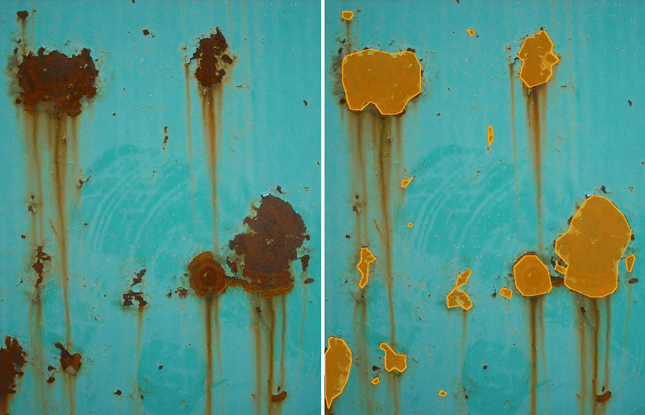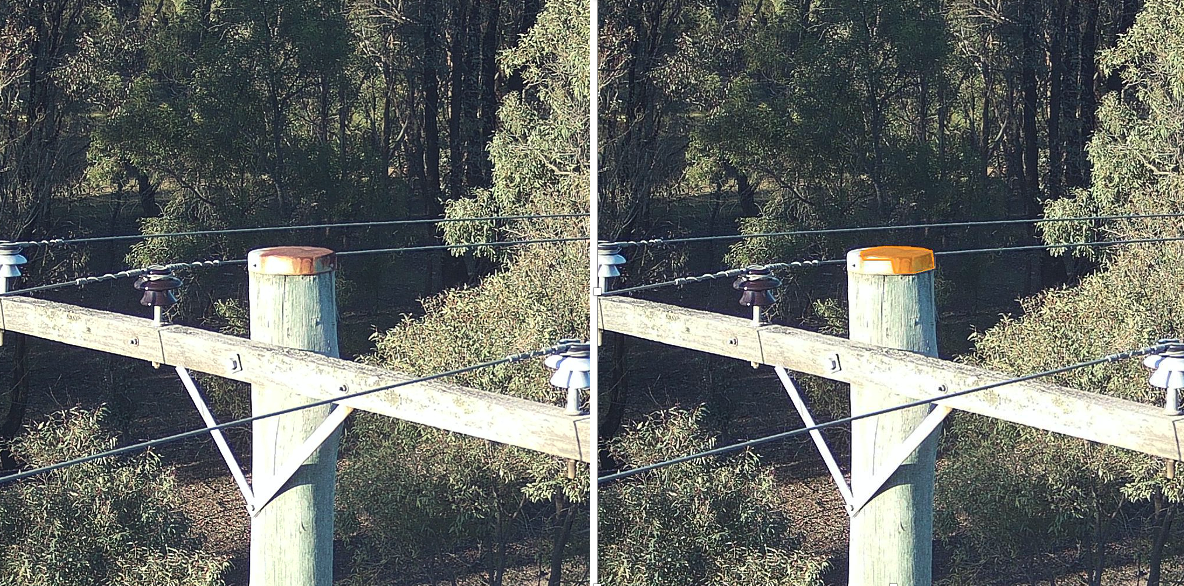Perhaps the main source of damage to human-made structures worldwide is corrosion. More often than not, corrosion takes the form of rust, the ochre coloured layer we all know and that develops over time on metal surfaces.
Given enough time, corrosion will eventually extend beyond the surface of the metal and lead to potentially catastrophic failure. Inspecting structures for corrosion is one of the main tasks in asset inspection worldwide, consuming extraordinary amounts of time and monetary resources. But what if there was a way to automate this procedure and to make it more reliable?

Side by side comparison: National Drones 'rusty' algorithm identifying corrosion
Utilising drone data
One way to speed-up the process of asset inspection is to fly drones equipped with cameras around a particular structure, something we are experts at doing at National Drones. Moreover, out proprietary platform Smartdata allows for seamless navigation of the collected data, as well as the integration of different data sources and formats, such as 3D models and point clouds. However, going through potentially thousands of images or navigating a 3D model in search of structural damage is still a time-consuming process. Ideally, potential areas of damage would be highlighted before a human can review them. Not only does this make the inspection process quicker but more objective and less prone to human error.
 Identifying rust on top of a power pole in Smartdata utilising Artificial Intelligence
Identifying rust on top of a power pole in Smartdata utilising Artificial Intelligence
Artificial Intelligence at the Core
At National Drones our vision is to have Artificial Intelligence (AI) at the core of what we do. For this reason, we are introducing automated corrosion detection into Smartdata, powered by Deep Learning. The process for the user could not be simpler: upload images of an asset to Smartdata in the same way as you would for other data outputs, choose whether you want AI to run through the images and highlight areas affected by corrosion. You can then choose to visualise the corroded areas at the touch of a button, greatly speeding up the process of inspecting assets that are impacted.
In time, we plan to add many other types of automated detection of structural damage to Smartdata, with the ultimate goal of producing automated reports and even predicting whether structures need repairs or if they are in danger of failing.
The use of deep Learning
Using Deep Learning for our corrosion has two main advantages: scalability and transferability.
Scalability
Scalability means that we can constantly add more data to the AI algorithm, and it will always improve its performance; so the more data we feed it the better the performance in detecting corrosion.
Transferability
Transferability means that we can use the AI to detect corrosion in any type of asset, irrespective of what type of data it was trained on. So, for instance, if we train the AI to detect corrosion in metal towers, it will do a good job of detecting it in bridges, without needing to change anything in algorithm. However, if we have image data for bridges, we can feed it to the model and augment it in order to make it better at detecting corrosion in this new type of asset.
Want to see the Benefits for your industry?
At National Drones we are very proud of our new corrosion detection algorithm, which we affectionately call “rusty”. We hope to see rusty develop into the best tool in the industry to detect corrosion. It already produced amazing results, even in its infancy. Many industries are set to transform rapidly utilising AI. With a constant need to innovate, drive efficiencies, and reduce costs we believe the application of aerial data and AI will be critical for businesses and change is already occurring.
Interested to learn more? Get in touch to discuss how we can help your business innovate.



